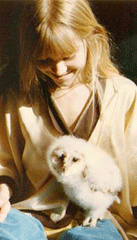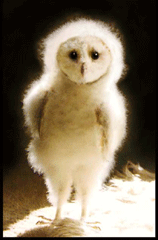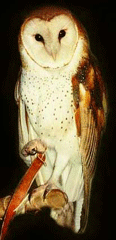Girl’s Best Friend
Air Date: Week of October 3, 2008

Stacey and a young, fuzzy Wesley. (Photo: Wendy Francisco)
Wesley the barn owl spent his life as the cherished companion of wildlife biologist Stacey O’Brien. O’Brien chronicles their nineteen years together in her book, “Wesley the Owl; The Remarkable Love Story of an Owl and His Girl.”
Transcript
GELLERMAN: Here’s a sound only a mother could love.
[OWL SOUNDS]
GELLERMAN: A mother…barn owl, that is.
[OWL SOUNDS CONTINUE]
GELLERMAN: It’s also a sound Stacey O’Brien loves. Stacey O’Brien loves a barn owl. She’s a wildlife biologist, who adopted a baby barn owl named Wesley. For nineteen years, woman and bird shared an apartment, and a life, which she chronicles in her new book, “Wesley the Owl: The Remarkable Love Story of an Owl and his Girl.” Stacey O’Brien joins me from public radio station KUCI in Irvine, California. Hi, Stacey.
O’BRIEN: Hi.
GELLERMAN: Let me ask you to start with a reading from your book. Page 204 starts with “throughout our years together.” You see it?
O’BRIEN: Yeah. “Throughout our years together, we had a cuddle ritual almost every night before bed. I would scoop him up with one hand cupped under his tummy, then cradle him in my left arm with his head resting in my hand. One evening, however, as I was lying down and rubbing him under his wings, Wesley pushed with his feet, so that he was lying on my chest with his head up under my chin. Then, he rustled a bit, and slowly began to open both delicate golden wings, stretching them as far as they would go and laying then across my shoulders. He slept that way for a long time, and I stayed awake in awe.”
GELLERMAN: A cuddling ritual.
O’BRIEN: Yes. Unheard of.
GELLERMAN: But you know, Stacey, I think some people hearing this would say “that’s one strange bird” and they might not be talking about Wesley.
[LAUGHING]
O’BRIEN: Well, you know, in the wild, Wesley would have done that with his mate. And they’re extremely affectionate in the wild. So he was doing what he would do in the wild naturally. So what I was trying to do was provide him with an experience as close to what would be natural as possible.

Wesley. (Photo: Stacey O’Brien)
O’BRIEN: He was my son. He was my baby. He was my little boy. But not in a condescending way. He was also my equal, because he was another species, another intelligent life form. And I respected his culture, and he respected mine.
GELLERMAN: I want to back up just a little bit. You met Wesley when he was just an owlet. You were working at Cal Tech as a biologist, and Wes was just a little tiny owl and he had a bum wing.
O’BRIEN: Yeah, he was just a little – about three or four days old, and a hiker found him apparently, down under a nest and brought him into Fish and Game. And when they find an unreleasable animal, they have a hard time placing it – any wild animal. Because all the facilities are pretty full. Zoos are full, rehab centers are full. So sometimes they would bring owls like that to Cal Tech because we had the facilities. We had big, beautiful facilities for owls. But this guy needed to be raised like an infant. So they asked me to take over his care for the rest of his life, and I did. He moved in with me. So I put him in a little nesting box, and he went everywhere with me. Oh. It was hopeless. I was completely smitten.
GELLERMAN: Now, when I hear you talk about Wes, I’m wondering, are you projecting your emotions, human emotions onto this animal.
O’BRIEN: Well, you know, that’s one thing that behavioral biologists used to worry about more than they do now. Of course, I have my own emotions about Wesley. But, I also knew a heck of a lot about barn owls already. So I knew what he would need. And in the wild, they can become very attached, first to their mother and then to their mate. So that was normal for him. He was very emotional about me. And for him to have a good experience of life, as he would in the wild, he needed an emotional connection, just like a human would.
GELLERMAN: Barn owls aren’t pack animals, they’re not members of a flock. They’re loners and they do mate for life.
O’BRIEN: Yes. So there are some really specific problems that come with that. So we’re used to the sort of social interactions where you would correct someone else, like a wolf will snap at another wolf and say, “stop that,” you know? And the other wolf will understand that it’s a correction.

(Photo: Stacey O’Brien)
GELLERMAN: There are a lot of myths about owls. There’s one in France I saw, it says that an owl can help a woman find a husband.
[LAUGHING]
O’BRIEN: Well, it didn’t work that way for me.
[LAUGHIN]
GELLERMAN: No, I was going to say – you know, Wesley did just the opposite.
O’BRIEN: Yes he did.
GELLERMAN: He was jealous when you would bring a boyfriend in.
O’BRIEN: Well for one – in one way he was a good litmus test, because I was surprised that some guys were jealous of him and were threatened by him. And I thought that was so childish, you know. So, immediately they were out the door, you know. Forget it. I don’t want this kind of childishness.
GELLERMAN: But my question is, was Wesley jealous of your boyfriends?
O’BRIEN: He seemed to accept that I had friends in my own species. It confused him. But he seemed to sense instantly if the guy didn’t like him. Again, anything that seemed aggressive, he thought was a threat on my life too.
GELLERMAN: What did you think? You say he was your son.
O’BRIEN: Yeah, I didn’t see him as a mate, of course. I’m a regular human being.
[LAUGHING]
O’BRIEN: You know, I don’t look to a bird for ….
[LAUGHING]
GELLERMAN: You recorded Wesley, right?
O’BRIEN: Yes, I put a lot of effort into trying to record his various sounds. When he decided to make me his mate, he started up with this rocking the house, extremely loud sound, that just vibrated the walls. Eventually, I was able to get that on tape because he did it every single day from then on. It was his way of calling me to come spend time with him. Would you like to hear it?
[WESLEY’S CALL]
GELLERMAN: Oh yeah, sure.
[CALL CONTINUES]
O’BRIEN: That is his nesting call. He’s trying to call me. And boy, you know, that’s a loud sound. It rockets out through the forests and out through the canyons. And if he doesn’t have a mate, it will call a female to him. So it serves a dual purpose. If he has a mate, she’ll come to be with him. If he doesn’t have a mate, he will find one that way. And he found many, many females that way that came directly to our bedroom window and hovered at the bedroom window looking in to see if he was a lone owl or mated owl.

Stacey and Wes. (Photo: Wendy Francisco)
O’BRIEN: I would go to him because the sound was so loud.
GELLERMAN: You didn’t chirp back, did you?
O’BRIEN: No, I talked English, and he spoke owl. You know, he had his – and that’s a whole other subject, actually you know. I would go to him and speak in my language, never expecting that he was actually learning what I was saying in different situations and then eventually understanding almost everything I said. And then, the really surprising thing was that he started to develop his own variations of each of his normal owl sounds that would mean specific things. He had, for example, about twenty variations of the natural begging sound. And they were specific for certain things like one meant he wanted – he was begging for a magazine. He liked to rip up magazines. Another one meant he was begging for water. So, anyways, he developed his own language system, and he made that leap across from understanding what I was doing with symbolic language, I think, to creating his own symbolic language, with his own owl sounds.
GELLERMAN: I know that you brought another sound with you. What is that?
O’BRIEN: This is a sound that, when I recorded it, it had never been recorded by a biologist or noted by a biologist, and it was Wesley’s mating sound, when he was mating. Not the mating call to bring a mate, but the sound he made when he was actually mating with me.
[WESLEY’S MATING SOUND]
GELLERMAN: I gotta ask you, Stacey, when he was giving his mating call, what were you doing?
O’BRIEN: You mean when he was mating with me?
GELLERMAN: Yeah.
O’BRIEN: Aacch, well there was no hope. I mean, it – and this is – I’ve talked to other people who have an imprinted bird with the same problem – you cannot, you cannot fight them off. I mean, if they want to mate with – they’ll pick a place on like your hat or they’ll – or your shoulder.

(Photo: Stacey O’Brien)
[LAUGHING]
GELLERMAN: We’re not giving the book away if we say that Wes dies after 19 years. What now? Is there another owl in your life?
O’BRIEN: I would like there to be. That’s my goal, really. But I would require another permit, because my permit was just for Wesley, for one owl.
GELLERMAN: Stacey, as I was reading your book I was thinking, is this woman nuts?
O’BRIEN: Oh no.
[LAUGHING]
GELLERMAN: Well, and then – as I’m reading the book, I come to kind of understand this unique relationship.
O’BRIEN: Really? Oh good, well I’m glad you understood it because I don’t want to come off like a strange bird. Because I’m perfectly normal. I mean – well – that’s why I put the day in the life of a biologist in there. This is not even that wild, you know, compared to the monkey guy or the spider guy or the guy with the parasites in his skin, you know? I didn’t have parasites in my skin. I thought I was doing pretty good.
[LAUGHING]
GELLERMAN: Well Stacey, I really enjoyed talking with you. Thank you very much.
O’BRIEN: Thank you.
GELLERMAN: Stacey O’Brien’s new book is called “Wesley the Owl: The Remarkable Love Story of an Owl and His Girl.”
[MUSIC: Blue Aeroplanes “Owls” from Bop Art (Setanta Songs )]
Links
Living on Earth wants to hear from you!
Living on Earth
62 Calef Highway, Suite 212
Lee, NH 03861
Telephone: 617-287-4121
E-mail: comments@loe.org
Newsletter [Click here]
Donate to Living on Earth!
Living on Earth is an independent media program and relies entirely on contributions from listeners and institutions supporting public service. Please donate now to preserve an independent environmental voice.
NewsletterLiving on Earth offers a weekly delivery of the show's rundown to your mailbox. Sign up for our newsletter today!
 Sailors For The Sea: Be the change you want to sea.
Sailors For The Sea: Be the change you want to sea.
 The Grantham Foundation for the Protection of the Environment: Committed to protecting and improving the health of the global environment.
The Grantham Foundation for the Protection of the Environment: Committed to protecting and improving the health of the global environment.
 Contribute to Living on Earth and receive, as our gift to you, an archival print of one of Mark Seth Lender's extraordinary wildlife photographs. Follow the link to see Mark's current collection of photographs.
Contribute to Living on Earth and receive, as our gift to you, an archival print of one of Mark Seth Lender's extraordinary wildlife photographs. Follow the link to see Mark's current collection of photographs.
 Buy a signed copy of Mark Seth Lender's book Smeagull the Seagull & support Living on Earth
Buy a signed copy of Mark Seth Lender's book Smeagull the Seagull & support Living on Earth

